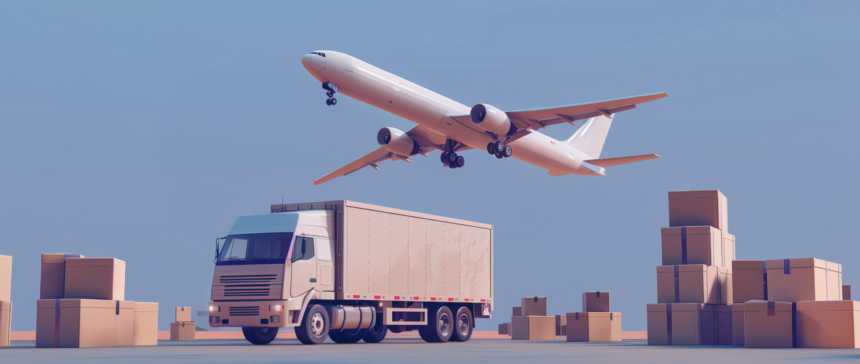When thinking about running a successful ecommerce business, shipping might not be the first thing that comes to mind. However, while it’s a behind-the-scenes process, it’s crucial for keeping your company thriving.
Shipping is also one of the most complex aspects of operating a business. If you’re not confident in your understanding of the different shipping types, now’s the time to brush up.
We’ve gathered all the information you need to inform your shipping strategy. We’ll explore the most common types of shipping, what they mean for your business, and when it makes sense to use them or switch from one type to another. We’ll even look at how definitions vary among top carriers.
Pro tip: Shopify Shipping offers discounts of up to 88% with major carriers like UPS, USPS, and DHL.
- Expedited shipping
- Overnight shipping
- Priority Mail
- Flat-rate shipping
- Economy shipping
- Multiple addresses
- Local delivery or pickup
- International shipping
- Freight shipping
1. Expedited shipping
Expedited is a blanket term meaning faster than standard shipping time. Each carrier has unique branded names and definitions for expedited shipping, so what applies to one carrier may not apply to another.
You’ll need to research each carrier to truly understand the shipping times and rates of an expedited shipment. Here are examples of expedited shipping services and delivery times for the most popular carriers.
UPS Expedited Shipping
The United Parcel Service (UPS) typically doesn’t use the term “expedited,” except for the UPS Worldwide Express Critical service:
USPS Expedited Shipping
The United States Postal Service (USPS) primarily uses Priority Mail and Priority Mail Express for expedited shipping services. Within the US:
- Priority Mail is usually delivered within one to three business days
- Priority Mail Express is delivered in one to two days
USPS Ground Advantage is another expedited shipping option. It delivers small packages in two to five business days and regular mail in one to five business days.
DHL Expedited Shipping
Within the US, DHL expedited shipping is branded as SmartMail. For international delivery, it’s called International Direct, but the shipping options remain the same:
- SmartMail Parcel & Parcel Plus: Expedited Max delivers in two to three business days, and Expedited delivers in two to five days
- Parcel International Direct: three to 10 business days
2. Overnight shipping
Overnight shipping means the package will arrive the day after it’s shipped. Different carriers often use unique branded terminology for this service.
For example, UPS Next Day Air or Next Day Air Saver provides overnight shipping through UPS. The Next Day Air Saver rate to deliver a one-pound shipment is $31.91. However, prices increase depending on the shipping zone and delivery location.
Overnight shipping rates can add up quickly. However, if you’re partnered with a platform offering pre-negotiated discounts, you can save significant money. For instance, a Shopify plan member would pay $14.04 for this shipment after an automatic 56% discount.
USPS doesn’t offer a guaranteed overnight option, but their Priority Mail Express service delivers in one to two days maximum.
3. Priority Mail

Unlike many other shipping terms, Priority Mail is a brand name rather than a standard shipping method. It’s a USPS-created term and is offered only by USPS. (Don’t let the name mislead you—it functions similarly to other ecommerce shipping methods like expedited and overnight shipping.)
Priority Mail generally ships within the US in one to three business days, depending on origin and destination. For specific dates, check the USPS Priority Mail Delivery Map.
In addition to standard Priority Mail, there’s Priority Mail Express, offering two-day or next-day shipping time by 6 p.m. the next day or your money back. Flat-rate shipping is available with both standard and express Priority Mail options. For international shipping, use Priority Mail International or Priority Mail Express International.
USPS will pick up packages for free at your home or office and it offers perks like USPS Tracking and up to $100 worth of insurance with qualifying shipments. These services are also available for international shipments.
4. Flat-rate shipping
Unlike typical shipping costs, which depend on a package’s size, shape, and weight, flat-rate shipping eliminates these variations.
You pay a single, “flat” rate every time you ship a specific-sized box issued by the carrier. It doesn’t matter how heavy the box is—you can fill it with as many items as possible and still pay the carrier’s flat rate.
Flat-rate shipping can save you money in the long run if you’re shipping heavy items or multiple items inside one box. However, if your packages are lighter, flat-rate shipping may cost you more. This is because carriers generally pad the pricing to cover heavier items.
Each carrier has its own shipping boxes and associated rates. For example, here are the five flat-rate options offered by UPS for shipments anywhere inside the US:
- Extra small: $10.95 and up; box dimensions like 4-inch cubes, 6 in x 4 in x 4 in, 8 in x 6 in x 2 in
- Small: $14.15 and up; box dimensions like 6-inch cubes, 8 in x 6 in x 5 in, 12 in x 9 in x 2 in
- Medium: $16.90 and up; box dimensions like 8-inch cubes, 12 in x 9 in x 6 in, 13 in x 11 in x 2 in
- Large: $22.30 and up; box dimensions like 10-inch cubes, 12 in x 12 in x 7 in, 15 in x 11 in x 6 in
- Extra large: $27.60 and up; box dimensions like 12-inch cubes, 16 in x 12 in x 9 in, 18 in x 12 in x 6 in

5. Economy shipping
Economy shipping is a low-cost option for non-urgent deliveries with longer delivery times. Depending on the distance and logistics involved, delivery times can range from a few days to several weeks. Those who prioritize costs over speed usually choose this type of shipping.
If you want to cater to the 62% of online shoppers who demand free shipping, economy shipping tends to be the most effective way to do it. It’s the cheapest way to ship packages, limiting the impact on your profit margins when covering the cost of free delivery.
Economy shipping is also ideal for large, bulky, or heavy shipments that would be cost-prohibitive to send through faster, more expensive shipping methods. For example, you can ship an item from $5 that will arrive within two to five business days with USPS Ground Advantage.
6. Multiple addresses
While “multiple addresses” isn’t technically a type of ecommerce shipping service, it’s a feature many commerce and ecommerce store owners consider offering.
This term refers to letting a customer send different items in a single order to different destination addresses. For example, they might buy a t-shirt for themselves and a t-shirt as a gift for their friend, but purchase both through the same order on your site.
Another use for multiple addresses is when customers want to combine different fulfillment methods to collect their items, like standard shipping, local delivery, in-store pickup, and digital delivery of a gift card.
Of course, this option adds some logistical complexities to order fulfillment. You’re not obligated to offer it, so feel free to skip it if you think it complicates things. If you’re interested in offering it, check out Shopify’s app ecosystem for a tool that can help.
7. Local delivery or pickup
If you’re a local business selling to customers in your area, you may have the option to skip shipping altogether. This can greatly benefit small businesses—customers don’t need to be subjected to possible shipping delays. You don’t need to worry about working with a carrier to get your products where they need to go.
With local delivery, you can go into your Shopify dashboard, set a specific radius around your store or warehouse, and create settings based on ZIP and postal codes. If a customer’s address is within that zone, they automatically become eligible for local delivery.
The primary consideration for local delivery is your team’s bandwidth. Will you deliver packages personally, or do you have team members to help? Keep this in mind when you’re setting up the details.

With a local pickup option, nearby customers can come to your store or warehouse to pick up their orders in person. While this option requires a bit of extra effort from your customers, you’ll find that many are happy to do so if you’re nearby.
8. International shipping
International shipping originates from a different country than the destination. When you venture into international shipping, you’ll need to consider several additional factors:
- Customs declarations and forms: These tell customs officers in the destination country what’s inside, the cost or value, and whether it’s merchandise or a gift.
- Applicable taxes, tariffs, and duties: Remember, your customer will be responsible for any extra customs and shipping fees. Add a clear warning to your website to prevent surprises. Shopify Markets is the best way to scale your ecommerce business internationally.
Determining costs can be complex because shipping prices vary widely depending on your origin and destination countries.
Shopify Shipping simplifies international shipping management. When you fulfill an order using its shipping labels, Shopify automatically generates the appropriate documentation—a commercial invoice and an export packing list—that every shipment needs when leaving the country.
9. Freight shipping
Businesses use freight shipping to transport large quantities of goods, typically on pallets and shipping containers. Generally, a shipment qualifies as freight if it weighs more than 150 pounds or is larger than 30 inches by 30 inches by 30 inches.
Commerce businesses typically use freight to ship mass quantities of products to a distributor or fulfillment center. From there, they can use regional or local shipping methods to get products to customers. If your online store has grown significantly and you face increasing shipping demands, freight may be a good solution.
Types of freight shipping include:
- Air freight via planes
- Ocean freight via ships
- Ground freight via trucks
- Multimodal freight via a combination of vehicles
Check with the carriers you’re considering to get a freight shipping quote. Many don’t offer upfront pricing—they opt for custom quotes instead. Remember that shipping time and rate depend on transport mode, origin and destination, size and weight, and any special handling requirements.
Offer different ecommerce shipping options with Shopify
As you can see, the world of shipping can be complex, especially when you consider the different details across carriers and services.
When determining the best types of shipping for your business, shop around to ensure you fully understand all your options. This approach will help you find your perfect combination.
Shopify Shipping allows you to manage your entire shipping strategy under one roof. You can buy discounted labels and create shipping rules that allow your customers to pick the type of shipping that works best for them.
Or, if you’d prefer to outsource the entire shipping and fulfillment process, consider the Shopify Fulfillment Network. It’ll connect your store with Flexport, a leading logistics partner that will manage the entire shipping process for you.
Types of shipping methods FAQ
What is the best shipping method?
The best shipping method depends on your parcel’s size, delivery location, and customer preference. Expedited shipping suits customers who don’t mind paying a premium for quick delivery, whereas economy is ideal for those who want free shipping at no extra cost.
What is the cheapest shipping method?
USPS Priority Mail Express offers the cheapest shipping method. It promises to deliver parcels within two days, and commercial shipping rates start at $26.35 for a flat-rate envelope.
What is the standard shipping type?
Economy shipping is the standard type of shipping. It’s the cheapest option, and parcels can be delivered within as little as two days. It is available through most shipping partners.







